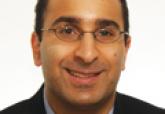BALTIMORE—Patients with stroke and obstructive sleep apnea (OSA) are more likely than patients without these conditions to have atrial fibrillation, said Melissa Lipford, MD, a neurologist and sleep specialist at Mayo Clinic in Rochester, Minnesota. If physicians detect atrial fibrillation in this patient population, the finding may lead to more effective preventive stroke treatment, Dr. Lipford said at the 32nd Annual Meeting of the Associated Professional Sleep Societies.
“In patients who present with cryptogenic stroke, if they have a known history of moderate to severe OSA, perhaps these are candidates where we would give higher consideration to doing long-term monitoring to screen for occult arrhythmia. If we find it and put them on anticoagulation therapy, they will be at a 40% to 70% reduced risk of having a stroke, compared with only 20% if we maintain antiplatelet therapy.”
Physicians must confirm that a patient has atrial fibrillation before starting anticoagulation therapy, however, she said. “We cannot just start them on warfarin because of the risk of bleeding. If you have patients on aspirin therapy, their risk of a major bleed is probably only 0.5% per year. The risk is doubled with warfarin in the lowest-risk patients. But if you tack on age, hypertension, and other risk factors, that goes up to almost a 12% per year risk with warfarin,” she said. “In every patient you have to do a risk–benefit analysis…. If you document atrial fibrillation, that risk of having a stroke is so high that the risk of a stroke outweighs the risks of anticoagulation in most cases.”
Potential Mechanisms
Dr. Lipford described a 65-year-old man with cryptogenic stroke who was found to have severe OSA. Although 24-hour telemetry monitoring showed no evidence of arrhythmia, he could be a candidate for 30-day noninvasive ambulatory heart monitoring, Dr. Lipford said.
“Typically, in these patients, we put them on aspirin and generally control their risk factors,” she said. “Knowing that this patient has severe OSA … we might consider more strongly long-term cardiac monitoring to help screen for occult atrial arrhythmia.”
Atrial fibrillation affects as many as six million people in the United States, including 9% of patients over age 65. It increases a person’s risk of stroke fivefold, Dr. Lipford said.
“Unfortunately, atrial fibrillation is commonly undetected,” she said. Many patients do not have symptoms. Patients may have paroxysmal disease. Some patients only have episodes at night.
Cardiogenic embolism accounts for between 20% and 30% of ischemic strokes each year. Most of these strokes are due to atrial fibrillation, Dr. Lipford said. About 60% of these strokes are severely disabling, and 20% result in death.
Gami and colleagues examined the prevalence of OSA in patients with and without atrial fibrillation. Patients with atrial fibrillation were more likely to have OSA, compared with patients without atrial fibrillation (49% vs 32%). Mansukhani et al found that in patients with OSA and a history of stroke, about 50% had a history of atrial fibrillation or atrial flutter, compared with 10.8% of patients with OSA and no history of stroke.
Data from the Sleep Heart Health Study indicate that patients with severe OSA have an increased risk of atrial fibrillation, compared with patients without sleep-disordered breathing (4.8% vs 0.9%).
After procedures such as cardioversion, patients with untreated OSA are more likely reconvert to atrial fibrillation, Dr. Lipford said. Kanagala and colleagues found that 82% of patients with untreated OSA had recurrence of atrial fibrillation at 12 months after cardioversion, compared with 42% of patients with OSA who used continuous positive airway pressure (CPAP) therapy and 53% of controls with no history of OSA.
Various mechanisms could explain the relationship between OSA and atrial fibrillation. Apnea episodes are associated with surges in heart rate, which may trigger arrhythmia. Patients exert tremendous force to try to open occluded airways, which may lead to left atrial enlargement. Recurrent hypoxemia and hypercapnia irritate the myocardium, which also may trigger arrhythmia. In addition, untreated OSA may be associated with hypercoagulability, which heightens patients’ risk of cardioembolism.
